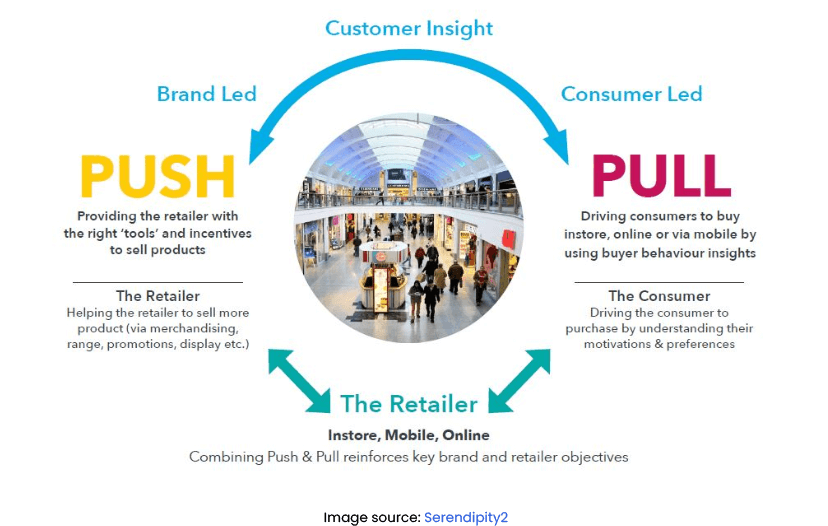
Click the button to start reading
Push and Pull Marketing Strategies: How to Find the Perfect Fit for Marketing Success
Picture yourself at a fork in the road. Each path represents a different way to attract customers.
On one side, you focus on building your brand slowly through word-of-mouth and organic growth. On the other side, you aim for quick sales by targeting immediate purchases.
Both options are tempting. But which path should you choose?
In this blog post, we’ll define push and pull marketing, exploring their unique approaches in detail. Plus, we’ll learn when and how to use a push-and-pull marketing strategy. Ready to discover the path that suits your goals best?
Let’s dive in!

What Is a Push Strategy in Marketing?
Push marketing involves pushing the product or service directly to the target audience. The main goal is to generate demand by actively promoting the product to potential customers.
An example of push marketing is a company that puts ads on websites or social media platforms. These ads are shown to many people even if they haven’t shown interest in the product. The company hopes the ads will catch their attention and make them interested in what they offer.
Why is the push marketing strategy effective?
In the world of digital advertising, push marketing strategies are still highly effective. Experts predict that global internet advertising revenue will keep growing. In fact, it may reach an estimated $723.6 billion in 2026! This means that businesses are investing heavily in push marketing tactics such as display ads or paid search.
What Is a Pull Strategy in Marketing?
Pull marketing is about creating a demand for a product or service by attracting and engaging potential customers. Instead of pushing the product directly, pull marketing aims to pull consumers toward the product. As a result, companies generate interest and desire.
An example of pull marketing is a company creating valuable blog posts and sharing them on social media. When the company provides helpful information, people see it as a friend who cares for them.
Why is the pull marketing strategy effective?
Pull marketing has become a popular choice among marketers. Studies show that 73% of B2B marketers and 70% of B2C marketers incorporate content marketing into their strategy. This shows the emphasis on pull marketing tactics, such as building communities and relying on organic discovery.
Besides, consumers highly value organic discoveries and recommendations from their peers. In fact, data says that 92% of consumers trust recommendations from friends and family more than any other form of advertising. This, again, emphasizes the importance of pull marketing strategies. They help to connect and generate positive word-of-mouth.
Different forms of push and pull marketing strategies
Once you know the various forms of pull and push marketing, you’ll see their differences more clearly:
Push marketing methods:
- Television advertisements
- Radio spots
- Outdoor billboards
- Direct mail campaigns
- Trade shows and exhibitions
Pull marketing methods:
- Content marketing
- Search engine optimization (SEO)
- Social media marketing
- Influencer partnerships.
- Referral programs.

How Do Push and Pull Strategies Work?
Imagine you’re a toymaker, and you want to sell your awesome new toy to kids. Here’s how push and pull strategies work:
Push Marketing: In push marketing, you take charge and push your toy directly to the kids. You use all sorts of exciting methods to get the word out about your toy.
For example, you might make cool commercials that pop up on TV or create eye-catching posters to put up in toy stores. You want to make sure your toy is everywhere so that kids can’t help but notice it!
Pull Marketing: In the case of pull marketing, you create a special aura that makes the kids want to come to you. How do you do this? Yes, by being super cool and fun!
You create a website or social media page where you share exciting stories and videos about your toy. Then, you make sure your online presence is so awesome that kids can’t resist checking it out. You might even team up with popular kid influencers who can’t stop talking about how amazing your toy is. This way, kids are pulled in, like bees to honey, because they’re genuinely excited about what you offer.
What Is the Difference Between Push and Pull Marketing?
The key difference between push vs pull marketing is the approach they take. Push marketing is more direct and proactive, where you actively promote your product to customers.
On the other hand, pull marketing is more customer-centric. Here, you focus on understanding your customers’ needs and preferences. You create interesting content and build relationships accordingly.
Hence, the next key difference. Push marketing emphasizes one-way communication, where the brand initiates the conversation. Conversely, pull marketing fosters two-way engagement. How? It encourages customers to actively interact with the brand.

Besides, push marketing allows the marketer to have more control over the message and distribution channels. However, pull marketing relies on customers’ own initiative and preferences.
And one final note. Push marketing, as a rule, aims for immediate results, while pull marketing focuses on long-term outcomes.

Pull vs. Push Strategy in Marketing: Which One Is Best for Your Business?
So, which one suits your business? The bold push or the enchanting pull? Or, perhaps, the match of both? Let’s find out.
Remember, before you choose your strategy, you should define your business goals.
Pull marketing is often the main business strategy for companies looking to…
Engage their customers. Companies desiring meaningful engagement prefer pull marketing strategies. Captivating storytelling. Interactive social media campaigns. Personalized experiences. These are their tools to create a bond that goes beyond a simple transaction.
Build brand loyalty. For companies focused on building a loyal customer base, pull marketing becomes critical. First, they deliver valuable content. Second, they offer exceptional customer service. Finally, they encourage open dialogue. As a result, they create a sense of trust and loyalty.
Become a thought leader in the field. And then, we have the ambitious players who want to be seen as thought leaders. For them, pull marketing comes to the rescue. They use informative blog posts, webinars, podcasts, and more to showcase their expertise. By doing this, they become trusted sources of knowledge for their customers.
Foster organic growth. When it comes to achieving long-term success, companies know that pull marketing is the way to go. Once they provide genuine value to their audience, they pull in the right people. This way, they build connections that stand the test of time.
Push marketing is often the primary business strategy for companies looking to…
Generate immediate sales. For quick results and immediate sales, companies base themselves on push marketing. They promote products through ads, direct selling, and persuasion, urging customers to take action.
Create product awareness. When it’s time to introduce new products or increase awareness, push marketing guides companies. Eye-catching ads, commercials, and promotions help them make a big impression on a wide audience.
Expand distribution channels. Finally, you should choose push marketing strategies if you want to expand your reach and enter new markets. For example, trade shows, exhibitions, and personal selling help secure new partnerships.

How to Choose Between a Pull vs. Push Strategy in Marketing?
Choosing between a push and pull marketing strategy is like navigating uncharted waters. Fear not. We’re here to guide you through this challenging quest.
Four easy steps to finding your best fit
Step 1: Know your business.
Take a moment to understand your business, its goals, and its unique characteristics. Is your product something that customers actively seek out? Or does it require a little nudge to grab their attention? Understanding your offering will help steer you in the right direction.
Step 2: Know your customers.
Next, dive into the depths of your target audience. Who are they? What are their preferences, habits, and desires? Are they more receptive to bold marketing that grabs their attention? Or do they prefer discovering hidden gems through organic channels?
Step 3: Plot your course.
Is your product groundbreaking and innovative? Does it solve a specific problem? If yes, push marketing can help you showcase your brand’s brilliance to the world. You can capture attention through advertisements, direct selling, or eye-catching displays.
But if your product relies on building desire and engaging your audience, pull marketing is your compass. You’ll build compelling content, use the power of social media, and create a strong online presence.
Step 4: Test the waters.
Once you’ve picked your course, set sail with your chosen strategy, but remain vigilant. To find a push and pull marketing strategy that works, track customer responses and measure their engagement. This will, without a doubt, help you adapt your course.
Applying the pull and push marketing strategies to the buying process
Now, let’s delve into the thought-provoking part. We’ll map the buying process for our customers and see which strategy fits where.
The awareness stage. At the beginning of the buying process, during the awareness stage, pull marketing takes the lead. By creating valuable content and engaging on social media, you attract customers.

The consideration stage. As potential customers progress to the consideration stage, both pull and push marketing come into play. Push marketing nudges them further along the process. Targeted ads, personalized emails, and direct sales outreach help push them to consider your brand. Meanwhile, pull marketing continues to provide valuable content and resources, nurturing their trust.
The decision stage. Finally, in the decision stage, push marketing takes a central role. This is when you want to emphasize your unique selling points, limited-time offers or discounts. By using time-sensitive and compelling deals, you encourage people to choose your brand. It’s like providing that final nudge to sway their decision in your favor.
Putting It Together: Combining Push and Pull Marketing Strategies

Now, here’s a secret. Implementing a push and pull marketing strategy can help balance immediate and long-term results.
That’s why sometimes, the best marketing strategy is a mix of both push and pull. You can use push marketing to make sure your product gets noticed everywhere. Then, you can use pull marketing to create a buzz and make customers feel like they’re missing out if they don’t have your product. By combining these strategies, you’ll have customers lining up to get their hands on your offer.
Ultimately, the best marketing strategy for your business depends on many factors. One, your unique goals. Two, your target audience. And three, the nature of your product or service.

Beware of Drawbacks: The Cons of Push and Pull Marketing
To better understand the differences between push and pull marketing, it’s useful to know the cons of each approach.
Cons of push marketing:
- Resistance to the push: Sometimes, customers may resist your pushy approach. They may feel bombarded with messages and become wary.
- Limited engagement: Push marketing often offers limited opportunities for interaction and engagement. You’re like a performer on stage who is delivering a captivating show. But the participation from the audience may be limited.
- Costly endeavors: Push marketing campaigns can be quite expensive. You need to be careful because the costs of advertisements, promotions, and direct selling efforts can add up quickly.
Cons of pull marketing:
- Time and patience: Pull marketing requires time and patience to yield results. Building a strong online presence, establishing credibility, and nurturing relationships take time.
- Competitive landscape: In the vast ocean of pull marketing, you’ll face stiff competition. Many other brands are competing for attention, making it challenging to stand out. So, you need to shine brighter than the rest to capture the spotlight.
- Uncertain conversion: Yes, pull marketing excels at attracting leads. But does it convert them into actual buyers? This can be unpredictable. Not every engaged customer will buy immediately.
Thus, when developing your marketing roadmap, consider these cons of a push and pull marketing strategy. Assess these disadvantages against your business goals, and you’ll be able to design a more effective plan.

How to Set Up Your Marketing Strategy with Teamly?
To set up your marketing strategy in Teamly, follow these simple steps. First, customize templates to fit your needs perfectly. Then, divide your campaigns into smaller tasks and assign them to team members.
As the tasks progress, use Teamly’s helpful features to track their status. Communicate effortlessly and share files smoothly using the collaboration tools. Keep track of time with the built-in time tracker, and get a clear picture of progress with Teamly’s Kanban boards.
Lastly, analyze campaign performance and make informed decisions by generating reports. With Teamly, you can streamline your processes and deliver projects confidently.
Conclusion
The success of a push and pull marketing strategy lies in creating a dynamic and well-planned approach.
To achieve this, you must first gain a clear understanding of your macro and micro marketing environment. Second, you need to delve into the depths of customers’ behavior, needs, and preferences to truly connect with them.
And don’t forget to arm yourself with the right tools. Use modern software and project management solutions that contribute to your marketing efforts.
Happy marketing!
















